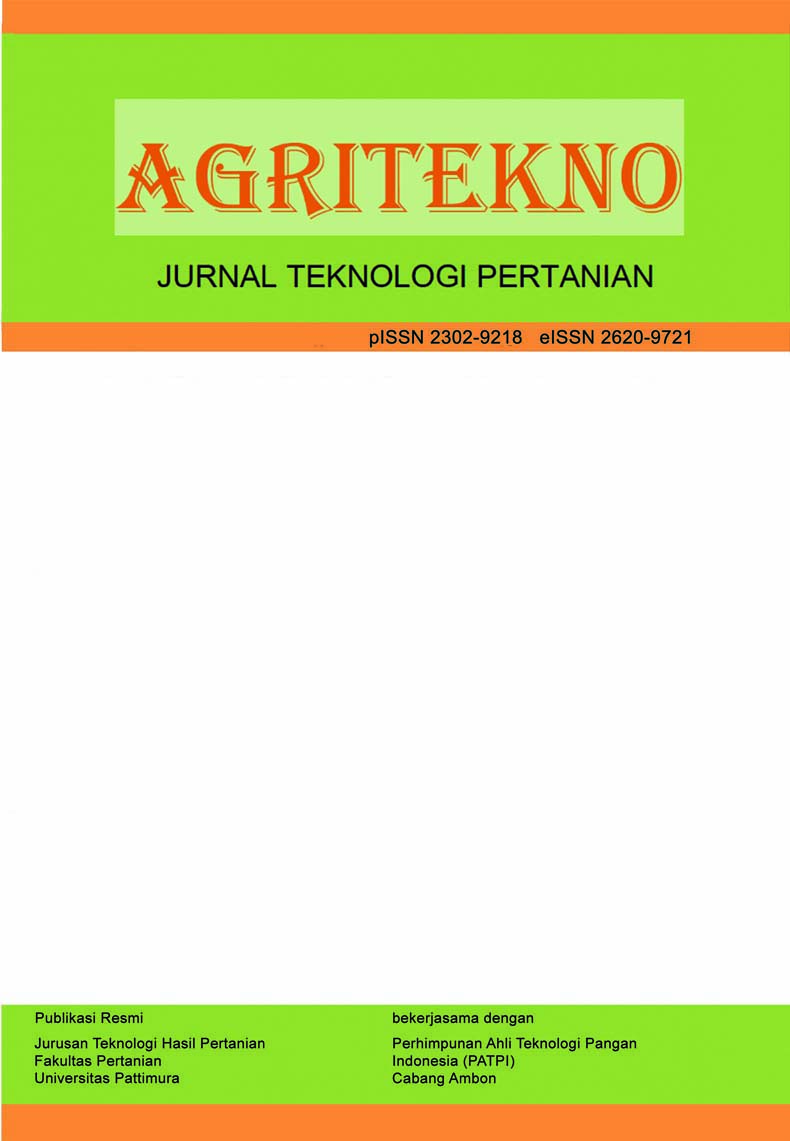Pengaruh Penambahan Ikan Tuna Asap Terhadap Karakteristik Kimia Kukis Kenari Sebagai PMT Balita Stunting
The Effect of Adding Smoked Tuna Meat on the Chemical Characteristics of Walnut Cookies
Abstract
Cookies, a type of snack favored by children and adults, are typically rich in energy but low in protein. Cookies made with canarium nuts as a raw material offer an alternative to increase protein value while providing energy. The issue of stunting, which has become a national concern, requires attention from various sectors, including universities contributing through innovative research. One such research topic is the addition of smoked tuna meat to canarium nut cookie dough, aiming to enhance the nutritional value of canarium nut cookies and provide a supplementary food option for children under five affected by stunting. This study aimed to analyze the effect of adding smoked tuna meat on the chemical characteristics of canarium nut cookies, which can serve as supplementary food to address stunting issues. The study employed a Completely Randomized Design with one factor: the concentration of smoked tuna meat, comprising six levels: 0%, 2%, 4%, 6%, 8%, and 10% smoked tuna meat. Each treatment level was repeated twice. The results indicated that canarium nut cookies with a 2% concentration of smoked tuna meat were the best according to the Indonesia National Standard (SNI), exhibiting the following chemical content: moisture content of 4.99%, ash content of 1.36%, protein content of 12.7%, fat content of 12.7%, and carbohydrate content of 70.26%.
Downloads
References
[AOAC] Association of Official Analytical Chemist, A. (2016). Appendix F: Guildlines for Standard Method Performance Requirements. AOAC Official Method of Analysis. AOAC International: p-18..
Badan Standarisasi Nasional. (2018). Standart Nasional Indonesia. Syarat Mutu Kue Kering (cookies). SNI-2973-2018. Jakarta: Badan Standart Nasional.
Daroyani, D. I., Yusasrini, N., & Sugitha, I. (2022). Pengaruh perbandingan ikan tuna (Thunnus sp) dengan puree jantung pisang (Musa paradisiaca sp.) terhadap karakteristik nugget. Itepa: Jurnal Ilmu dan Teknologi Pangan, 11(2), 322-333.
Falimurat, Q., Febrianti, T., Mustakim, M. (2022). Faktor risiko kejadian stunting pada balita di negara berkembang. Jurnal Ilmu Kesehatan Sandi Husada, 3(3), 308-315. https://doi.org/10.20473/amnt.v3i3.2019.122-129
Fendjalang, S. N. (2017). Analisis Kimia Ikan Tuna Asap pada Beberapa Pasar Tradisional di Tobelo, Kabupaten Hamahera Utara. Seminar Nasional Kemaritiman dan Sumber Daya Pulau-Pulau Kecil, 1, pp. 174-178.
Herawati, B. R., Nanik, S., & Yannie, A. W. (2018). Cookies tepung beras merah (Oryza nivara) – Mocaf (Modified Cassava Flour) dengan penambahan bubuk kayu manis (Cinnamomun burmanni). Jurnal Ilmiah Teknologi dan Industri Pangan, 3(1), 33-40.
Laboko, A. I. (2018). Pengaruh penambahan tepung ikan roa asap (Hermihampus sp.) terhadap mutu cookies. Jurnal Dunia Gizi, 2(1), 50-54. https://doi.org/10.33085/jdg.v2i1.4385
Mailoa M. (2013), Penambahan Tepung Ikan pada Campuran Tepung Pisang Tongka Langit dan Tepung Terigu untuk Dijadikan Biskuit. Ekosains 02(1) : 33 - 38
Mailoa, M., Widyaningsih, T. D., Putri, W. D., & Harijono. (2019). Fresh and roasted canarium nut (Canarium vulgare) altering the lipid profile of hypercholesterolemic rats (Rattus norvegicus). Eurasian Journal of BioSciences, 13(1), 231-238.
Nento, W. R., & Ibrahim, P. S. (2017). Analisa kualitas nugget ikan tuna (Thunnus sp.) selama penyimpanan beku. Journal of Agritech Science, 1(2), 75-81.
Ni’mah, C., & Muniroh, L. (2015). Hubungan tingkat pendidikan, tingkat pengetahuan dan pola asuh ibu dengan wasting dan stunting pada balita keluarga miskin. Media Gizi Indonesia, 10(1), 84-90. https://doi.org/10.20473/mgi.v10i1.84-90
Nusale B., Mailoa M., & Souripet A. (2023). Karakteristik kimia dan sensori cookies dengan penambahan kenari. Jurnal Agrosilvopasture-Tech, 2(1), 9-14. https://doi.org/10.30598/j.agrosilvopasture-tech.2023.2.1.9
Pakhri, A., Nur, Y., Hikmawati, M., & Sirajudin. (2017). Cookies dengan subtitusi tepung jewawut. Media Gizi Pangan, 24(2), 21-27.
Rahman, H., Anggadiredja, K., Gusdinar, T., Sitompul, J. P., & Ryadin, A. R. (2019). Kajian komposisi kimia, nilai nutrisi dan etnofarmakologis tanaman genus kenari. Fitofarmaka Indonesia, 6(1), 325-333. https://doi.org/10.33096/jffi.v6i1.431
Ramadan, Y., Augustyn, G.H., & Mailoa, M. (2023). Formulasi tepung sagu dan kacang merah dalam pembuatan kukis. Jurnal Agrosilvopasture-Tech, 2(2), 260-268. https://doi.org/10.30598/j.agrosilvopasture-tech.2023.2.2.260
Salindeho, N., & Frans, L. (2017). Aplikasi asap cair cangkang pala untuk pengolahan ikan selar. Jurnal Ilmu dan Teknologi Pangan, 5(1), 9-17.
Siregar, N. S. (2014). Karbohidrat. Ilmu Keolahragaan, 13(2), 38-44.
Sumbawa, K., Barat, N., District, L., Tenggara, W., Apriyanto , D., Subagio, H., & Sawitri, D. (2016). Pola asuh dan status gizi balita di Kecamatan Lape, Kabupaten Sumbawa, Nusa Tenggara Barat. Jurnal Gizi dan Pangan, 11(2), 125-134.
Trisyani, N., & Syahlan, Q. (2022). Karakteristik organoleptik, sifat kimia dan fisik cookies yang di subtitusi dengan tepung daging kerang bambu (Solen sp.). Agribisnis Perikanan, 15(1), 188-196.
USDA. (2019). National Nutrient Database for Standard References.
Widiantara, T., Zainal, D., & Yuniar, E. (2018). Kajian perbandingan tepung kacang koro pedang dan konsentrasi kuning telur terhadap karakteristik cookies koro. Pasundan Food Technology, 5(2), 146-152.
Copyright (c) 2024 The Author(s)

This work is licensed under a Creative Commons Attribution-ShareAlike 4.0 International License.
Authors who publish with this journal agree to the following terms:
- Authors retain copyright and grant the journal the right of first publication with the work simultaneously licensed under a Creative Commons Attribution License that allows others to share the work with an acknowledgement of the work's authorship and initial publication in this journal.
- Authors are able to enter into separate, additional contractual arrangements for the non-exclusive distribution of the journal's published version of the work (e.g., post it to an institutional repository or publish it in a book), with an acknowledgement of its initial publication in this journal.
- Authors are permitted and encouraged to post their work online (e.g., in institutional repositories or on their website) prior to and during the submission process, as it can lead to productive exchanges, as well as earlier and greater citation of published work (See The Effect of Open Access).









